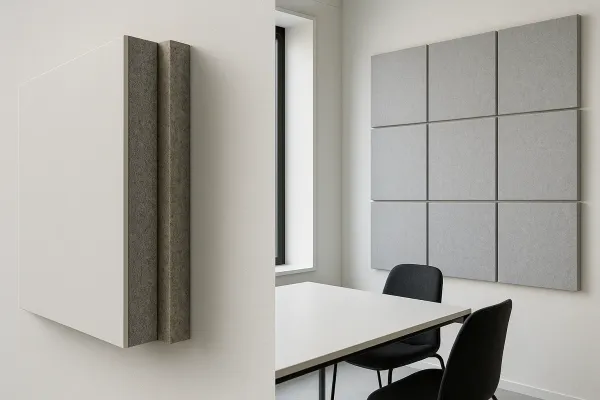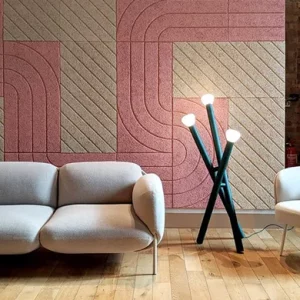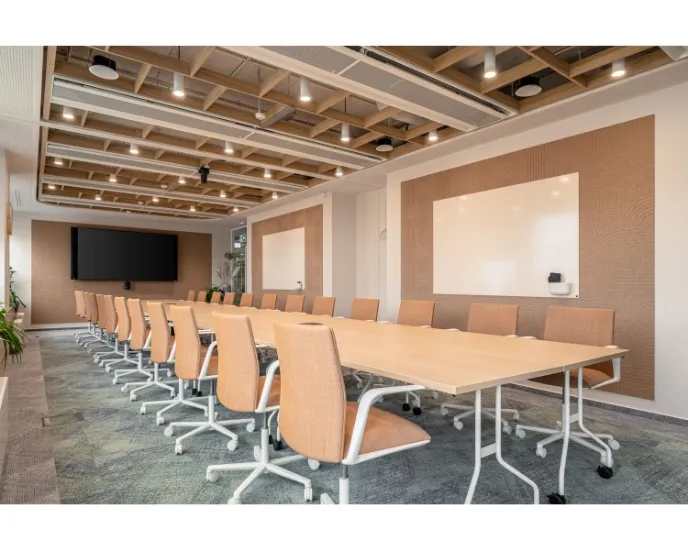Als het antwoord op je vraag op zich laat wachten, voer dan je WhatsApp/Skype in samen met het bericht, zodat we meteen contact met je kunnen opnemen.
Je krijgt binnen 24 uur antwoord. In dringende gevallen kun je WhatsApp/WeChat toevoegen: +86-13678899682.
Noisy rooms wreck meetings, strain focus, and kill design intent. You try “soundproof” tips, add akoestisch paneel ideas, and still hear echoes. Frustrating. Let’s understand the differences and pick the right fix—so you actually het geluid verbeteren you live with.
Soundproof panels aim to block sound from entering or leaving a space (sound isolation), while acoustic panels absorb sound within a room to reduce echo and reverberation. Think STC for blocking and NRC for absorbing. Most projects need a smart blend of both to enhance sound quality efficiently.
When we discuss difference between soundproofing en akoestische behandeling, we’re talking about two goals. Soundproofing aims to blokkeer geluid—stop sound transmission through walls, floors, doors, and the plafond—so noise doesn’t travel. Acoustic treatment manages reflections binnen een kamer naar geluidsgolven absorberen, tame nagalmen geluidskwaliteit verbeteren.

Geluiddempende vs akoestische panelen
In practice, soundproofing uses mass, airtightness, damping, and decoupling. Acoustic panels are generally porous and soft—materials like foam, PET felt, mineral wool, or fabric—to absorberen energy and reduce echo. One stops sound from entering or leaving a room; the other improves the akoestische omgeving you hear within a space.
“STC keeps noise out; NRC keeps echo down.”
That’s the simplest way to remember it.
Here are the key differences between acoustic panels (absorption) and soundproof panels (isolation). We’ll also show how they relate to common ratings:
| Attribuut | Acoustic Panels (Absorption) | Soundproof Panels (Isolation) |
| Primary goal | Reduce nagalm en geluid in een ruimte | Aims to block sound transfer between spaces |
| Typical rating | NRC (Noise Reduction Coefficient) 0.65–0.95 | STC (sound transmission class) 40–60+ (for assemblies) |
| Core mechanism | Porous absorption (e.g., PET felt, fabric-wrapped, akoestisch schuim) | Mass + airtightness + damping/decoupling |
| Where used | Rooms needing clarity: offices, schools, studios | Party walls, floors, doors, ceilings, enclosures |
| Quick heuristic | “Quiet the room” | “Keep the noise out/in” |
What’s the difference people feel? Acoustic panels de geluidskwaliteit verbeteren binnen the same room; soundproofing may not change echo at all, but it prevents sound from entering from next door.
If you hear the neighbor’s TV, you need soundproofing. If your own room is echoey and speech is muddy, you need acoustic treatment and soundproofing—well, acoustic treatment at least. Many projects use both in layers: isolation on assemblies; absorption mounted on walls or ceilings to calm reflections.
A quick test: clap once. If you hear a long tail, add absorption panels. If outside traffic bothers you, upgrade the partition (mass + sealing). Sometimes adding acoustic doors or seals yields outsized gains.
Absorbers control the way sound reflects. Open-cell materials like foam and PET felt geluid absorberen door te draaien geluidsgolven into tiny heat losses. Wood slat panels add tuned airflow resistance and diffusion to enhance sound and aesthetics. Acoustic fabric faces let panels breathe while protecting cores.

Akoestische panelen van PET-vilt
Schuimpanelen remain popular for recording studio corners and early-reflection points. PET felt is durable, cleanable, and design-friendly in offices and schools. Our panels are made with PET, E0-grade binders, and low-VOC components to support healthy interiors.
Geluiddempende materialen focus on mass and airtightness: dense boards, laminated drywall, MLV, and properly sealed assemblies. For higher performance, use staggered studs or resilient channels to reduce mechanical coupling—this reduces geluidsoverdracht.
Acoustic panels vs those heavy layers: acoustic panels are not for isolation. They do not geluid tegenhouden through a weak wall; they manage sound within a room. Think of them as the “finish” for room acoustics, not the structure for sound isolation.
Start with first reflections (side muur of plafond points). In talk-heavy rooms, ceiling clouds or baffles are highly efficient because they intercept early reflections from many directions. In recording studio rooms, treat side walls and add bass control.
For open offices, a blend of wall panels, ceiling baffles, and soft furnishings het geluid verbeteren landscape. Balanced coverage lets you control the way sound behaves without over-deadening.
Short answer: no. Porous absorbers are made to Bevochtig reflections, not to stop sound from entering or exiting partitions. If you plan on soundproofing a room, address the construction: add mass, seal gaps, and decouple layers. Then use absorption to enhance sound quality.
That said, smart absorption placement can make a room feel much quieter because it lowers geluid binnen—you’ll talk softer, and HVAC or keyboard noise won’t linger.
NRC predicts how well a product absorbs mid-to-high frequencies. Values near 1.00 indicate strong geluidsabsorptie. STC rates a wall/door/window assembly’s resistance to geluidsoverdracht (mostly speech frequencies). These are different tests, so don’t compare them 1-to-1.
Typical ranges: PET felt NRC 0.75–0.95; slat panels 0.55–0.85 (depending on backing); common office walls STC 35–45; high-spec walls STC 50–60+. Use both ratings together to select solutions for sound control that fit your goals.
Industry references: ASTM E90 (transmission, STC) and ASTM C423 (absorption, NRC). See ASTM International, ASAen ASHRAE for standards and guidance.
Ja. Difference between akoestische behandeling and “just panels” is scope. Treatment includes strategic layout, bass control, diffusers, and space planning. Sometimes furniture, partitions, and curtains are part of the plan. Acoustic panels are typically the backbone, but placement, coverage, and balance matter as much as SKU choice.
For premium results, combine absorbers with diffusion and bass traps. This yields a lively yet controlled akoestische omgeving that feels natural and comfortable.
Office: We installed PET panels and suspended clouds to de geluidskwaliteit verbeteren binnen an open hub. Result: clearer speech and lower stress. Managers reported a 30–40% reduction in perceived noise (post-occupancy survey).
Classroom: Wood slat absorbers along rear walls plus ceiling baffles cut nagalm by >40% (from ~1.2 s to ~0.7 s). Teachers noted fewer repeats per lesson.
Recording studio: Porous absorbers at reflection points with bass traps in corners. Clients praised tighter imaging and punch.
“Panels are popular** because they’re fast to install, scalable, and designer-friendly.”

PET panels applicated in office
And remember: vs acoustic isolation, absorption is not a substitute; they work together.
Wij zijn een professionele fabrikant in China of PET and wood akoestische panelen for global B2B buyers—distributors and importers of building materials, architecten en interieurontwerpers, aannemers for large commercial/public projects, and brand owners seeking OEM/ODM. We supply custom sizes, fire ratings, colorways, E0 emissions, and fast lead times.
Explore relevant solutions on our site:
Absorption (NRC):
Isolation (STC):
These are indicative; real results vary by build quality, sealing, and junctions (doors, glazing, penetrations).
Do acoustic panels block sound from entering or exiting a space?
No. Absorbers manage sound within a space; they don’t seal or add mass. To prevent sound, address the assembly—mass, damping, and airtightness—to stop sound from entering or exiting.
Can foam or felt replace proper isolation?
No. They Bevochtig reflections but won’t stop geluidsoverdracht through partitions. Use them after isolation upgrades to de geluidskwaliteit verbeteren binnen en enhance sound clarity.
What’s the best thickness for office panels?
For speech, 9–12 mm PET is effective. Combine area coverage (10–25% of room surface) with ceiling elements for balanced room acoustics.
Where should I start with a small budget?
Seal gaps first. Door sweeps and perimeter seals can yield big gains. Then place panels at first reflections to geluidskwaliteit verbeteren without over-spending.
Are fiberglass panels still relevant?
Ja. Fiberglass panels deliver strong mid/high absorption, often fabric-wrapped. PET felt is a designer-friendly, cleanable alternative with recycled content.
We manage multi-site roll-outs—can you customize?
Yes. As an OEM/ODM factory, we tailor dimensions, edges, perforations, veneers, and packaging—consistent SKUs across regions with fast, reliable logistics.
| Doel | Primary tool | Secondary tool | Opmerkingen |
| Stop neighbor noise | Isolation upgrades (mass, sealing, decoupling) | Add absorbers for comfort | Address flanking; check doors/windows |
| Reduce echo in a conference room | Absorbers (walls, ceiling clouds) | Light diffusion | Cover 15–25% of surfaces |
| Control bass in a studio | Porous traps + pressure traps | Early-reflection panels | Treat corners and first reflections |
| Improve privacy between rooms | STC-rated door + wall assembly | White noise (if allowed) | Airtightness is critical |
Onthoud: key differences matter because budgets are finite. Spend first where it counts.
We use PET from recycled content, formaldehyde-safe binders, and third-party emission tests. Wood veneers are FSC-available. Installers like that our systems are mounted on walls or ceilings quickly with low dust and clean edges. Acoustic panels are best suited for busy environments requiring quick turnarounds and durable finishes.
For isolation builds, check fire, seismic, and egress codes. Combine soundproofing solutions with proper construction details—back-to-back outlets, continuous seals, and flanking paths can make or break performance.
Looking to manage sound within your next build? Let’s collaborate—submit drawings and we’ll map isolation and absorption in one clear plan.
(Standards describe how geluidsoverdracht en geluidsabsorptie are tested; always verify product data sheets for exact ratings.)